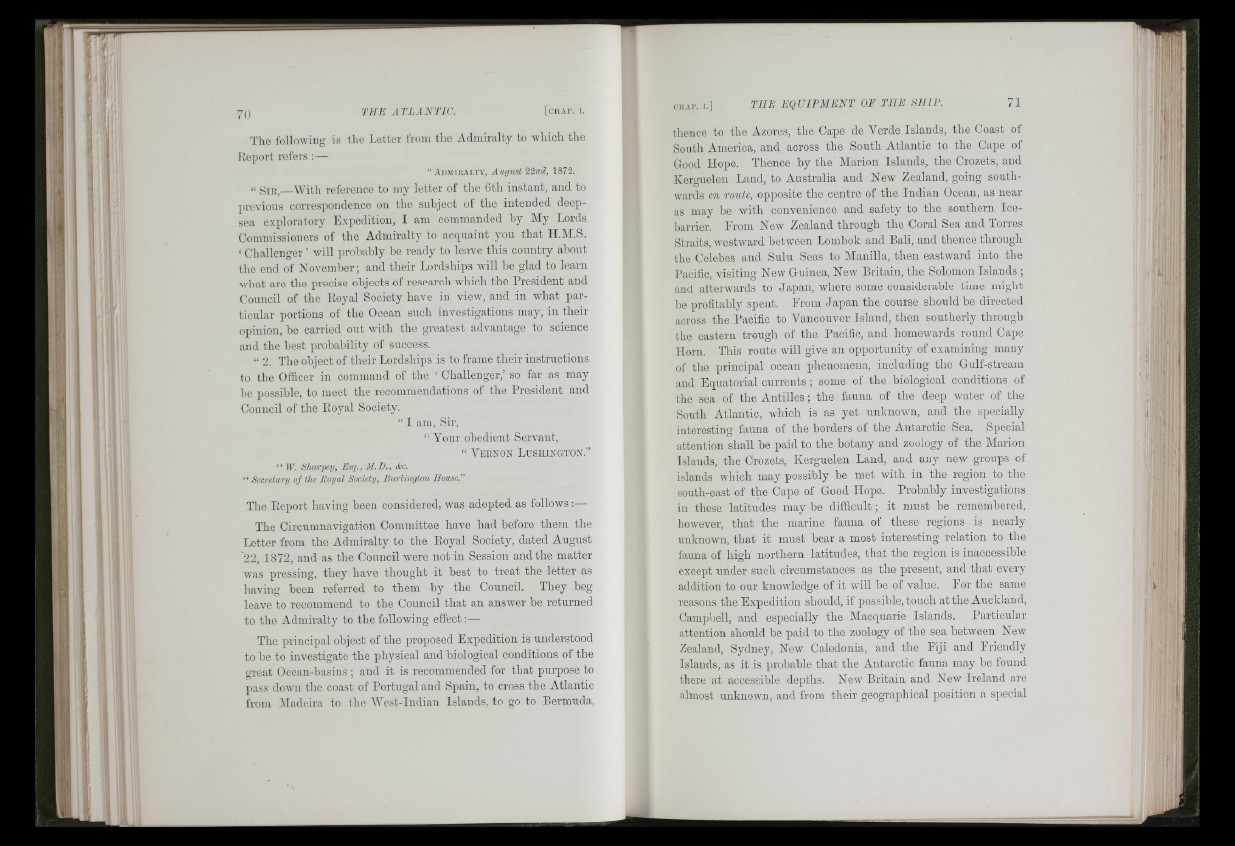
n-:
' -IS !,r'
The following is the Letter from the Admiralty to which tlie
Peport refers :—
“ A d m ik a l t y , August 22nd, 1872.
“ Sir, With reference to my letter of tiie 6th instant, and to
previous correspondence on the subject ot the intended deep-
sea exploratory Expedition, I am commanded hy My Lords
Commissioners of the Admiralty to acquaint yon that H.M.S.
‘ Challenger ’ will probably be ready to leave tins country about
the end of Novemiier; and their Lordships will he glad to learn
wliat are the precise objects of researcii which the President and
Council of the Poyal Society have in view, and in what particular
portions of the Ccean snch investigations may, in their
opinion, be carried out with the greatest advantage to science
and the best probability of success.
“ 2. Tlie object of their Lordships is to frame their instructions
to the Cfficer in command of the ‘ Challenger,’ so far as may
be possible, to meet the recommendations of tlie President and
Council of tiie Poyal Society.
“ I am, Sir,
“ Your obedient Servant,
“ Veenon Lushington.”
‘ ‘ I V. Sharpey, Esq., M. D ., Ac.
“ Scorclary of the Royal Society, Burlington House."
The Peport having been considered, was adopted as follows;—
The Circumnavigation Committee have had before them the
Letter from the Admiralty to the Poyal Society, dated August
22, 1872, and as the Conncil were n o tin Session and the matter
was pressing, they have thought it best to treat the letter as
having been referred to them by the Council. They beg
leave to recommend to the Conncil that an answer be returned
to the Admiralty to the following effect;—
The principal object of tlie proposed Expedition is understood
to he to investigate tlie physical and biological conditions of the
great Ocean-basins ; and it is recommended for that purpose to
pass down the coast of Portugal and Spain, to cross the Atlantic
from [Madeira to the West-Indian Islands, to go to Bermuda,
thence to tlie Azores, the Cape de Verde Islands, the Coast of
South America, and across the South Atlantic to the Cape of
Good Hope. Thence by the Marion Islands, the Crozets, and
Kerguelen Land, to Australia and New Zealand, going southwards
en route, opposite the centre of the Indian Ocean, as near
as may be witii convenience and safety to the southern Ice-
barrier. Erom New Zealand through the Coral Sea and Torres
Straits, westward between Lombok and Bali, and thence tlirongli
the Celebes and Suln Seas to Manilla, then eastward into the
Pacific, visiting New Guinea, New Britain, the Solomon Islands ;
and afterwards to Japan, where some considerable time migiit
be profitably spent. Erom Japan the course siiouid be directed
across the Pacific to Vancouver Island, then southerly through
the eastern trough of the Pacific, and homewards round Cape
Horn. This route will give an opportunity of examining many
of the principal ocean phenomena, including the Gulf-stream
and Equatorial currents ; some of the biological conditions of
the sea of the Antilles; the fauna of the deep water of tlie
South Atlantic, wliich is as yet unknown, and the specially
interesting fauna of the borders of the Antarctic Sea. Special
attention shall be paid to the botany and zoology of the Marion
Islands, the Crozets, Kerguelen Laud, and any new groups of
islands wliich may possibly be met with in the region to the
south-east of the Cape of Good Hope. Probably investigations
in these latitudes may be difficult; it must be remembered,
however, that the marine fauna of these regions is nearly
unknown, that it must bear a most interesting relation to tlie
fauna of high northern latitudes, that the region is inaccessible
except under sucii circumstances as the present, and tliat every
addition to our knowledge of it wiil be of value. For tire same
reasons the Expedition should, if possible, touch at the Auckland,
Campbell, and especially the Macquarie Islands. Particular
attention should be paid to the zoology of the sea between New
Zealand, Sydney, New Caledonia, and the Fiji and Friendly
Islands, as it is probable that the Antarctic fauna may be found
there at accessible depths. New Britain and New Ireland are
almost unknown, and from their geographical position a special
iiUiL